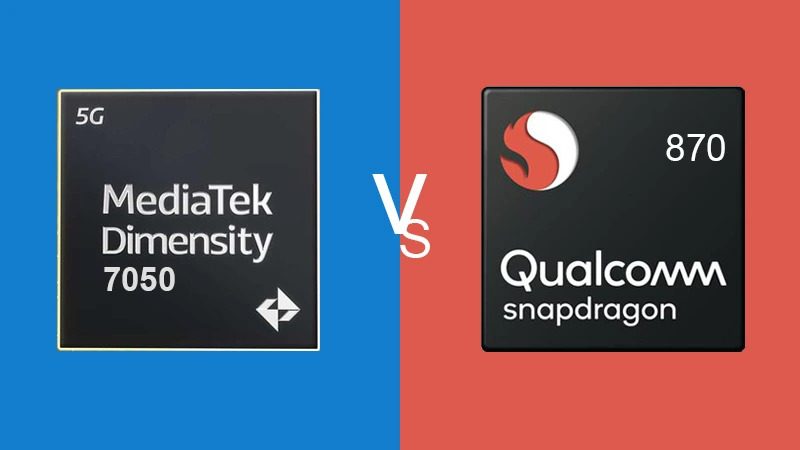In the ever-evolving boundary of mobile processors, two giants stand at the forefront: MediaTek Dimensity 7050 and Qualcomm Snapdragon 870. These powerhouses represent the pinnacle of mobile computing, each boasting its own set of strengths and advantages. In this comprehensive comparison, we’ll dissect the key differences between these two processors and determine which one reigns supreme in mobile performance.
Technical Specifications
Let’s kick off our analysis by delving into the technical specifications of both processors. The MediaTek Dimensity 7050, announced two years and four months after the Snapdragon 870, features a smaller transistor size at 6nm compared to Snapdragon’s 7nm. It also flaunts a higher GPU frequency, supporting up to 16% higher memory bandwidth.
On the other hand, the Snapdragon 870 impresses with a higher CPU clock speed and additional memory channels, offering 4 compared to Dimensity’s 2. Furthermore, it boasts a larger L3 cache, enhancing overall performance and responsiveness.
Performance Benchmarking
Performance is the ultimate measure of a processor’s capabilities, and both the Dimensity 7050 and Snapdragon 870 excel in this arena. The Snapdragon 870 showcases its prowess by delivering up to 2x better performance in floating-point computations and achieving a significantly higher AnTuTu 10 score, boasting a whopping 817K compared to Dimensity’s 562K.
However, the Dimensity 7050 fights back with its impressive RAM speed, 450 MHz higher than Snapdragon’s, and a GPU clock speed that outpaces its competitor by a staggering 700 MHz. These factors, combined with its smaller semiconductor size and lower thermal design power, contribute to a compelling performance proposition.
AI and Machine Learning Capabilities
Artificial intelligence and machine learning capabilities have become indispensable features in modern processors, enabling faster and more efficient processing of tasks such as audio, image, and video processing. Both the Dimensity 7050 and Snapdragon 870 integrate AI and ML functionalities, leveraging their respective architectures to deliver unparalleled performance gains.
Integrated Graphics and Thermal Design Power
Integrated graphics, or iGPU, play a crucial role in handling graphical tasks on mobile devices. Both processors utilize the system’s main memory for graphics processing and feature integrated graphics solutions. However, the Snapdragon 870 boasts a higher thermal design power of 10W compared to Dimensity’s unspecified TDP, indicating potentially more robust cooling requirements for the Qualcomm chip.
List of Smartphones
Here’s a list of smartphones featuring the MediaTek Dimensity 7050 and Qualcomm Snapdragon 870 processors:
MediaTek Dimensity 7050:
- Realme Narzo 60 Pro
- Realme 12+ 5G
Qualcomm Snapdragon 870:
- Realme GT Neo 3T
- iQOO 9 5G
- Xiaomi Pad 6
These smartphones offer a range of features and capabilities, catering to diverse user preferences and needs. Whether you prioritize performance, efficiency, or gaming prowess, there’s a device powered by either of these processors to suit your requirements.
FAQ’s
Which processor is more power-efficient, Dimensity 7050, or Snapdragon 870?
The Dimensity 7050's smaller semiconductor size and potentially lower thermal design power suggest it may offer better power efficiency compared to the Snapdragon 870. However, real-world power efficiency can vary depending on factors such as device optimization and usage patterns, so it's essential to consider overall system design and implementation when evaluating power efficiency.
Bottom Up
The MediaTek Dimensity 7050 and Qualcomm Snapdragon 870 represent formidable contenders in the competitive landscape of mobile processors. While the Snapdragon 870 shines with its superior CPU clock speed, additional memory channels, and larger cache size, the Dimensity 7050 holds its ground with higher RAM speed, faster GPU clock speed, and a smaller semiconductor size.

